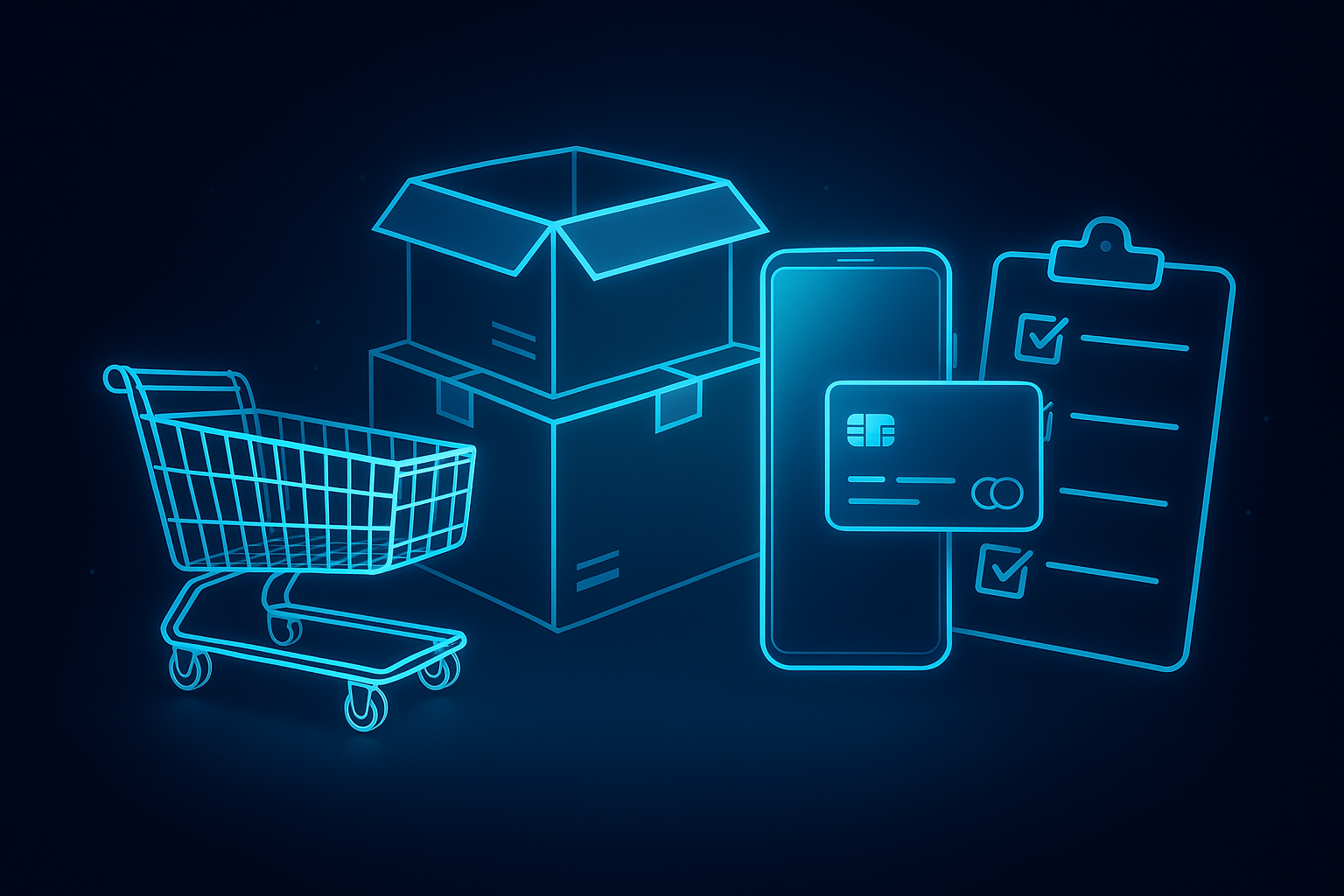.jpg)

AI Solutions for eCommerce: Tools & What to Know in 2025
Artificial intelligence (AI) is quickly changing how eCommerce businesses work, from delivering personalized shopping experiences to improving fulfillment processes and everything in between. Right now, nearly 89% of retailers use AI daily or test it through pilot programs. As the trend continues, companies that do not start using AI soon will struggle to meet customer expectations and stay competitive.
This article is a practical guide to the top AI solutions available in 2025. You will find real-world use cases and strategic tips to help you understand and use this powerful technology in your business.
✅ Key takeaways
- You should pick AI tools based on their data quality and how well they work with your existing systems, focusing on platforms that support flexible designs.
- AI-powered personalized product recommendations significantly boost customer experience and conversion rates, transforming how online shoppers discover and engage with products.
- Inventory forecasting and demand management are becoming AI-driven needs, with AI-powered forecasting cutting supply chain errors significantly.
- Ethical questions about bias, transparency, and data privacy grow more important as AI becomes common in customer-facing applications.
What counts as an AI solution in eCommerce?
Understanding what counts as AI in eCommerce helps you tell the difference between simple automation and smart systems that actually learn and adapt. Here are the four main types of AI solutions for eCommerce:
- Machine learning (ML) forms the base of most eCommerce AI applications. It uses algorithms to learn from past data and patterns to solve problems and get better results over time. This helps eCommerce platforms improve product recommendations, make pricing strategies better, and improve search results by studying customer behavior and sales data.
- Predictive analytics is another main AI ability. It uses past data and machine learning to predict future trends, customer behavior, and business needs. For instance, companies using predictive analytics in eCommerce can make better, more informed decisions about stock management and marketing campaign timing.
- Natural language processing (NLP) enables computers to understand and work with human language. NLP analyzes vast amounts of customer feedback, improves search by understanding what users want rather than just matching keywords, and powers chatbots that handle complex customer interactions. It can also process customer reviews, support tickets, and search queries to find useful insights and give relevant responses.
- Computer vision enables AI systems to understand visual information from images or videos. This enables features like visual search (where customers can search using images instead of text), automatic product tagging, and quality control in warehouses.
💡 The difference between automation and intelligence matters. Automation runs set tasks well, but AI adds learning, decision-making, and adaptation abilities. AI systems can also get smarter over time, changing their behavior based on new data and changing conditions.
6 core areas where AI is transforming eCommerce
Here are six core areas where AI is making a significant impact—plus the tools that are powering these capabilities:
1. AI-powered personalization
AI-powered personalization tailors the shopping experience to individual users by studying their browsing history, purchase patterns, demographics, and real-time behavior.
Machine learning algorithms constantly study customer data to predict preferences and deliver relevant content. These systems process multiple data points at the same time—from time spent viewing specific products to seasonal purchasing patterns—to build complete customer profiles that enable precise targeting.
The results? Dynamic product recommendations, personalized email content, customized homepage layouts, and individual pricing strategies that create truly personalized shopping experiences.
The business impact is major. Companies that excel at personalization generate 40% more revenue from these activities than average companies. Beyond immediate sales, personalization drives customer satisfaction and loyalty, with 80% of businesses reporting increased consumer spending when their experiences are personalized.
💡Tools to use
Popular AI personalization platforms include:
- Dynamic Yield
- Salesforce Commerce Cloud
- Adobe Sensei
- Bloomreach
These solutions integrate seamlessly with most existing eCommerce systems, enabling businesses to deliver tailored experiences without extensive technical overhead.
DJUST's platform complements these personalization efforts through custom catalogs and customer-specific pricing, creating a foundation that AI can further enhance with dynamic recommendations and behavioral insights.
2. Search and navigation optimization
AI-powered search changes how customers find products by understanding intent rather than just matching keywords.
Search systems use natural language processing to handle typos, understand synonyms, and understand conversational queries. Machine learning algorithms also study search behavior patterns to keep improving the relevance of results.
Additionally, visual search abilities let customers upload images and find similar products, expanding discovery beyond text-based queries. Other features like autocomplete, query suggestions, and smart filtering help guide users toward successful outcomes.
These smart search capabilities directly impact conversion rates by reducing friction in the product discovery process. When customers can quickly find what they want—or discover relevant alternatives—they are more likely to complete purchases. This is why effective eCommerce business plans always make customer experience and conversion optimization a priority.
💡Tools to use
Advanced search solutions like Algolia AI, Bloomreach Discovery, and Klevu provide comprehensive AI-powered search capabilities.
DJUST’s platform also includes search engine abilities with customizable filters and integration options that can be improved with AI tools for smarter and more personalized search results across B2B catalogs.
3. Pricing and promotions
For B2B companies, AI can improve complex pricing structures, including volume discounts, customer-specific rates, and contract-based pricing. The revenue impact is significant: AI-driven dynamic pricing can increase B2B sales revenue by up to 15%, helping businesses respond quickly to market conditions and improve margins.
AI improves pricing strategies and promotional offers by studying multiple variables at the same time: competitor pricing, demand changes, inventory levels, customer segments, and market trends. Machine learning models process this data to set the best prices that increase revenue while staying competitive.
This technology also enables personalized promotions, delivering targeted offers based on customer behavior and preferences rather than broad demographic segments. Companies focused on modernizing B2B eCommerce find that AI-powered pricing becomes a strong competitive advantage in complex business markets.
💡Tools to use
Specialized pricing optimization tools like Prisync, Wiser, and Pricefx provide AI-powered pricing improvement, while custom machine learning models can be built for specific business needs.
Additionally, DJUST's comprehensive pricing management features for volume prices and customer-specific pricing create the ideal data infrastructure that AI systems need to implement advanced dynamic pricing strategies.
4. Inventory and demand forecasting
AI enhances inventory management by predicting future demand with better accuracy. It can study historical sales data, seasonality patterns, market trends, and outside factors (like weather events or economic indicators) to forecast demand across different time periods and product categories.
For example, AI might recognize that certain products sell better together during specific seasons, or that events impact demand in predictable ways. This enables more accurate stock planning and automated reordering systems.
💡Tools to use
Enterprise-grade forecasting solutions include ClearDemand, Relex, and Logility (Demand AI+), along with AI modules built into enterprise resource planning systems.
DJUST's platform provides inventory and warehouse management abilities that these AI tools can enhance, while also offering AI-driven insights to optimize inventory and demand forecasting through its unified commerce platform.
5. Customer service (AI chatbots and agents)
AI-powered chatbots and virtual agents use natural language processing to understand customer queries, machine learning to improve responses over time, and integration with business systems to access real-time information about orders, products, and customer history.
Chatbots and agents go beyond simple FAQ responses to engage in meaningful customer interactions: They process complex queries, provide personalized help, and smoothly pass issues to human agents when needed. Advanced chatbots can even handle multiple conversation threads, remember context across interactions, and provide proactive support based on customer behavior.
This technology is particularly valuable for businesses implementing comprehensive B2B eCommerce solutions, where customer service complexity often exceeds traditional retail interactions.
💡Tools to use
Industry-leading customer service platforms include:
- Zendesk AI
- Intercom
- Salesforce Einstein Bots
- Tidio (Lyro)
These sophisticated tools can integrate with DJUST's order management system to provide customers with real-time information about their orders, account status, and product availability, creating more informed and helpful customer interactions.
6. Fraud detection and checkout optimization
Many businesses also use AI to enhance their eCommerce security. It works by machine learning algorithms processing millions of data points (transaction patterns, user behavior, device information, etc.) to spot unusual patterns that can signal fraud—such as unusual purchasing patterns, inconsistent shipping addresses, or suspicious device characteristics. Best of all, AI can adapt to evolving fraud tactics while reducing false positives that can frustrate legitimate customers.
Additionally, AI can improve checkout experiences by personalizing payment options, predicting the best shipping methods for individual customers, and making the purchase process smoother based on user preferences and behavior.
💡Tools to use
Comprehensive fraud protection services like Sift, Kount, and Forter deliver enterprise-level fraud detection capabilities. Plus, DJUST’s payment integrations and order management system provide an ideal foundation that AI fraud detection tools can improve.
Choosing the right AI tool: What to evaluate
Here is what to consider before choosing an AI solution:
Do you have enough quality data?
AI systems require enough volume and quality of data to work well. Check whether you have clean, accessible customer data, transaction histories, and product information. Even the most advanced AI tools will not deliver strong results if the data they use is not reliable.
Will it integrate with your current systems?
AI tools should fit smoothly into your current tech setup. Think about whether you need API-first solutions that connect with different tools, or an all-in-one platform with built-in functionality.
Composable commerce architectures—like those from DJUST—can help integrate AI across enterprise resource planning (ERP), customer relationship management (CRM), product information management (PIM), and other systems without losing coherence.
Can you understand how it makes decisions?
As AI takes on more decision-making, it is important to know how it reaches those decisions, especially when they affect customers or business outcomes. Clear, explainable AI helps with troubleshooting, staying compliant, and building trust with users and stakeholders.
What support and training do you need?
Look at the level of support and training the vendor offers. Consider how easy the tool is to use, whether detailed documentation is available, and what kind of learning curve your team might face. Some tools need technical know-how, while others are designed for business users with minimal training.
Is the vendor reliable and future-focused?
A vendor’s track record and future plans matter. Research their reputation, customer feedback, and approach to innovation. Make sure their roadmap aligns with your goals and that they’re committed to evolving with the technology, especially as AI continues to grow and change.
Ethical and strategic considerations of AI
As AI becomes more widely used in eCommerce, it is important to consider ethical and strategic factors that impact customer trust and long-term success:
Preventing unfair treatment through algorithmic bias
AI models can continue or amplify biases present in their training data, leading to unfair treatment of certain customer groups. Regularly audit AI systems for bias by testing outcomes across different demographic segments and ensuring your training data reflects the full diversity of your customer base.
Communicating AI’s role in customer experiences
While customers generally appreciate personalized experiences, they also want to understand how these are created. Clearly communicate to your customers how AI influences customer experiences, particularly in pricing, product recommendations, and personalized content.
Also, consider implementing AI transparency features that allow customers to understand and control their personalized experiences.
Ensuring compliance with evolving privacy regulations
Data privacy rules such as the General Data Protection Regulation (GDPR) and the California Consumer Privacy Act (CCPA) continue to evolve. So, make sure your AI systems comply with current regulations and that customer data is collected and used responsibly. Compliant B2B data management practices lay the groundwork for ethical AI and help protect both customers and your business.
Maintaining human connection where it matters most
AI should enhance, not replace, the human touch. Use it where it adds real value—like processing vast amounts of data for actionable insights or handling routine tasks—and preserve human interaction in moments that call for empathy, creativity, or complex judgment.
Establishing clear responsibility for AI system outcomes
As AI systems become more autonomous, it is critical to define who is accountable for their decisions. Create clear frameworks outlining responsibility, error handling, and oversight. This ensures AI tools operate within defined boundaries, especially important in areas like autonomous B2B marketplaces.
What is next for AI in eCommerce?
The future of AI in eCommerce promises even more sophisticated capabilities. Let’s explore below.
AI content creation beyond basic product descriptions
Generative AI is moving beyond simple tasks to support a wide range of eCommerce functions. Businesses are using it to write product descriptions, create marketing campaigns, respond to customer inquiries, and even produce images and videos for product catalogs. These tools (such as AI product description generators) make it possible to scale content production while keeping quality and consistency across large inventories.
More intuitive ways to discover and buy products
AI-powered voice commerce and visual shopping are creating more intuitive ways for customers to discover and purchase products. Voice-activated shopping through smart speakers and mobile devices enables hands-free purchasing, while advanced visual search allows customers to find products by uploading photos or using their camera to identify items in real-world settings.
Dynamic customer segmentation in real time
Instead of relying only on past behavior, AI tools will adjust segments and personalize content in real time—based on what customers are doing at that moment, where they are, and what they prefer. This results in personalized shopping experiences that feel highly relevant and timely.
AI-driven automation across the entire supply chain
Predictive fulfillment and autonomous warehouses will make the entire supply chain better through AI-driven automation. These systems will predict when orders will be placed, automatically allocate inventory, and manage warehouse operations with minimal human intervention. AI will optimize everything from inventory placement to picking routes, reducing fulfillment costs while improving delivery speed and accuracy.
Get ahead with AI and DJUST
AI solutions for eCommerce are no longer experimental—they have become practical tools that deliver real results.
From personalization engines that increase conversion rates and provide personalized recommendations to predictive analytics that optimize inventory management, AI helps businesses operate more efficiently while providing better customer experiences.
DJUST’s flexible platform makes it easy to integrate these AI tools without being limited by rigid systems. Book a demo today to see how you can start using AI in ways that match your business goals.





